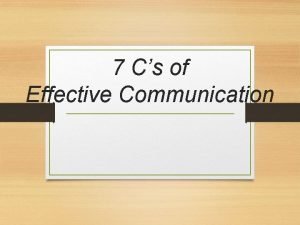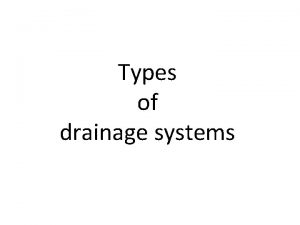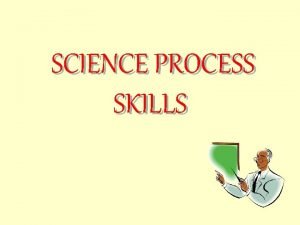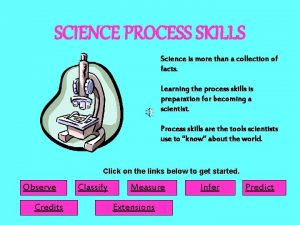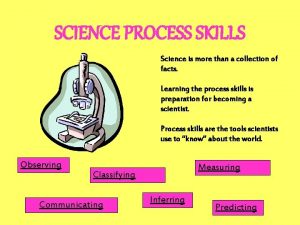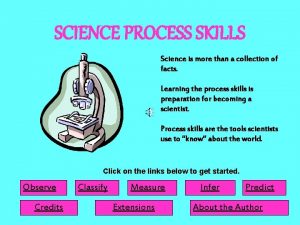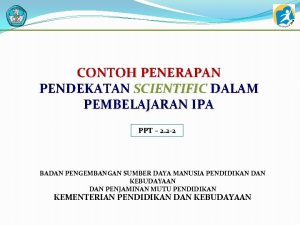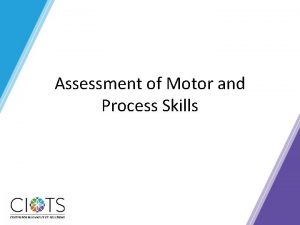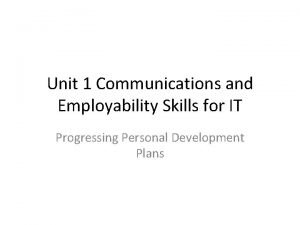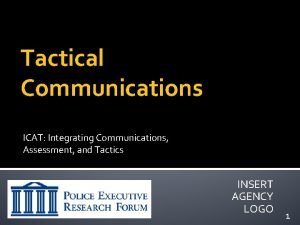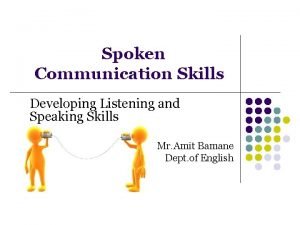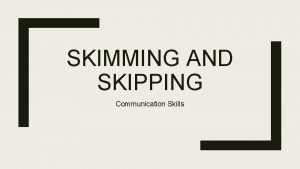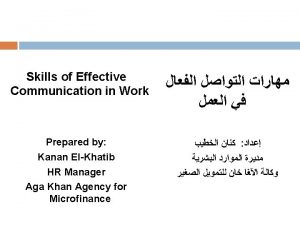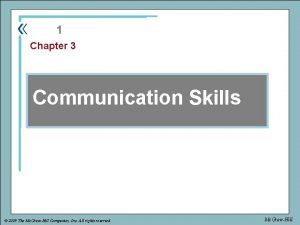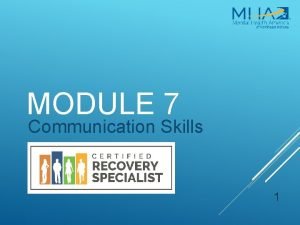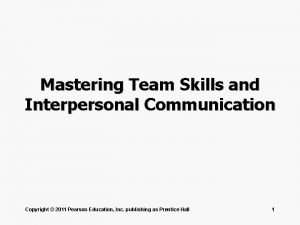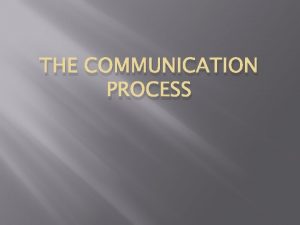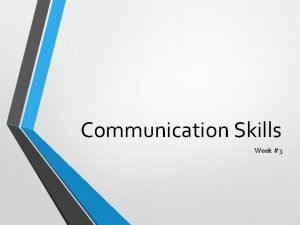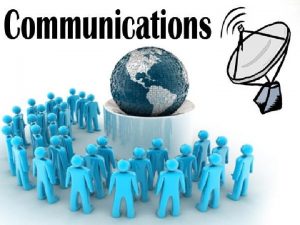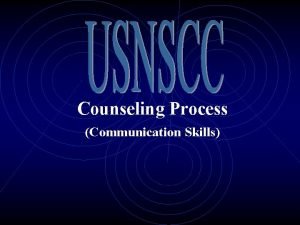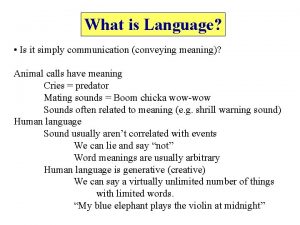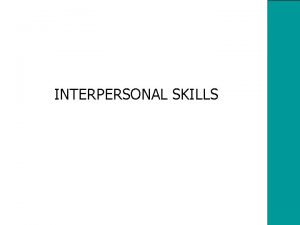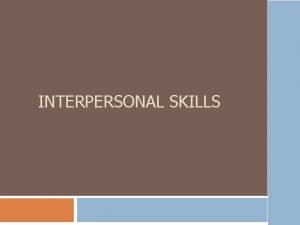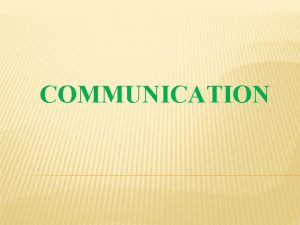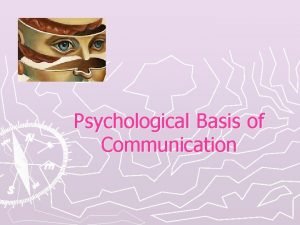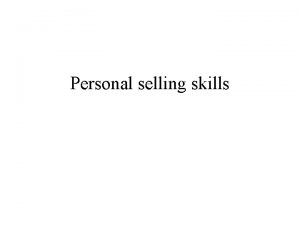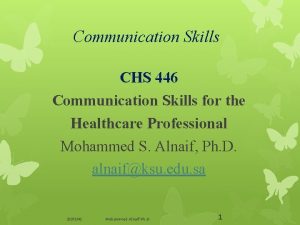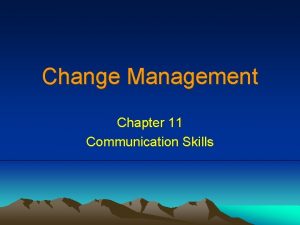COMMUNICATION SKILLS COMMUNICATION l l PROCESS OF CONVEYING























- Slides: 23

COMMUNICATION SKILLS

COMMUNICATION l l PROCESS OF CONVEYING A MESSAGE, THOUGHT, OR IDEA SO IT IS ACCURATELY RECEIVED AND UNDERSTOOD. Primary skills needed at Work – – Listening Writing Reading Speaking

EFFECTIVE COMMUNICATION l l l WHEN THE MESSAGE RECEIVED IS THE SAME AS THE MESSAGE SENT Ineffective communications occur more often than you might guess. To check for effective communication always wait for feedback from the receiver.

COMMUNICATION PROCESS Noise Encodes Noise Message Noise Decodes Receiver Sender Decodes Message Sender’s Environment Encodes Receiver’s Environment

COMMUNICATION PROCESS l l SENDER – the person who starts the communication and has an image of what he/she wants to communicate ENCODER- the sender’s mind which forms a mental image of the message being sent l l MESSAGE – something that is understood by the senses (usually spoken, written, or printed) CHANNELS – how the message is delivered (by voice, image, printed)

COMMUNICATION PROCESS l l RECEIVER – the person who gets the message DECODER – the receiver’s mind, which forms a mental image of the message received l l FEEDBACK – a clue that reveals what message was received NOISE – anything that interferes or interrupts the message

TYPES OF NOISE IN COMMUNICATION l MECHANICAL NOISE – l What are different mechanical noise that you know? PSYCHOLOGICAL NOISE – What are different psychological noise that you know?

LISTENING SKILLS l HEARING – RECOGNIZING SOUND l LISTENING – UNDERSTANDING WHAT YOU HEAR

WHY DON’T WE LISTEN WELL? INTERRUPTIONS v ASSUME WHAT IS GOING TO BE SAID v DISAGREE WITH SENDER v THINKING OF SOMETHING TO SAY/OR ABOUT SOMETHING ELSE v NOT HEARING WHAT IS SAID v DISTRACTED v DON’T UNDERSTAND v

LISTENING SKILLS: To be a good listener l l l Concentrate on what is being said Don’t become distracted Don’t interrupt the speaker, unless you don’t understand Ask for explanations when you don’t understand Provide feedback before responding, by rephrasing what you heard

SPEAKING SKILLS l l l SPEAK CLEARLY AND DISTINCTLY – avoid running words together. Example – whydoncha for Why Don’t You. SPEAK TO THE LISTENER – establish eye contact, and use words they understand SPEAK WITH A FRIENDLY AND COURTEOUS TONE – phrase things in a positive way, avoid arguing and complaining

SPEAKING SKILLS l l USE STANDARD ENGLISH – Example: Bob came here yesterday. Vs. Bob yesterday here TALK “WITH” THE LISTENER NOT “TO” THE LISTENER – keep message short and understandable, give the listener chance to provide feedback

NONVERBAL COMMUNICATION l ANY MESSAGE THAT DOES NOT USE WRITTEN OR SPOKEN WORDS – – BODY LANGUAGE FACIAL EXPRESSIONS GESTURES HAND SHAKES

TALKING ON THE PHONE l l ALWAYS ANSWER BEFORE THE 3 (THIRD) RING ANSWER WITH A FRIENDLY VOICE: state company name, your department, and your own name HOLD PHONE ABOUT 1 INCH FROM LIPS DON’T EAT, DRINK, OR CHEW GUM

TAKING A PHONE MESSAGE l l l Date Time of Call Name of the caller – ask how to spell if don’t know Name of person message is for The message itself Number to call back

TAKING A PHONE MESSAGE l After taking message read back to caller l End the conversation pleasantly l Give the person the message right away

SPEAKING TO A GROUP l l l PREPARING YOUR SPEECH – outline the main thoughts, limit yourself to 5 or less, organize in logical order GIVING YOUR SPEECH – tell them what you plan to tell them, and then tell them what you told them BEFORE GIVING YOUR SPEECH ALWAYS PRACTICE, PRACTICE!!!!!

READING AND COMPREHENSION SKILLS l l l COMPREHENSION – ability to understand the material Read with a purpose – know why you are reading and what you are expected to learn Look over the material – Skim readings and read what is important Try to read for meaning – Concentrate on what you are reading Improve your vocabulary – use dictionary to learn words you don’t know

WRITING AND KEYBOARDING SKILLS l l THE MOST IMPORTANT JOB SKILL TO AN EMPLOYER. WHY? – l l BECAUSE FEW PEOPLE POSSESS THIS SKILL WRITING SKILLS – composing written or printed communications in clear logical manner KEYBOARDING – allows you to type letters, memo’s, and other business communication that is the main form of communication in a business.

TYPES OF BUSINESS COMMUNICATIONS USING KEYBOARDING l. Business l. Memo’s l. Report’s Letters

COMMUNICATION TECHNOLOGY l l l COMPUTERS VOICE MAIL – CELLULAR PHONES – WALKIE-TALKIES – HEADSETS TELECONFERENCING AND VIDEO CONFERENCING -

INFORMAL COMMUNICATION CHANNELS l l l COMMUTING – when you carpool you will often find out information about your job that you wouldn’t find at work SHIFT CHANGES – you will find out what the person that was working before you finished or didn’t finish and what you need to do. WORK BREAKS – talking at the water cooler, can be good or bad, don’t let it be bad.

ASSIGNMENT l I will divide you into groups and you will read through the role-play and tomorrow you will be given 10 minutes to prepare and then we will do our role-plays.
 The activity of conveying information
The activity of conveying information 7 c's of communication completeness
7 c's of communication completeness 2 pipe system
2 pipe system Interpersonal vs intrapersonal skills
Interpersonal vs intrapersonal skills What are skills
What are skills Skills passport
Skills passport Manipulative skills in science
Manipulative skills in science Classifying science process skills
Classifying science process skills Science process skills predicting
Science process skills predicting Science process skills communicating
Science process skills communicating Predicting science process skills
Predicting science process skills Science process skills ppt
Science process skills ppt Assessment motor and process skills
Assessment motor and process skills Communication and employability
Communication and employability Tactical communication board questions
Tactical communication board questions Tactical communication skills
Tactical communication skills It is the spoken communication
It is the spoken communication Skimming in communication
Skimming in communication Download communication skills | مهارات التواصل
Download communication skills | مهارات التواصل How to write a schematic report
How to write a schematic report Characteristics of skimming reading
Characteristics of skimming reading Chapter 3 communication skills
Chapter 3 communication skills Basic communication skills module 7
Basic communication skills module 7 Mastering team skills and interpersonal communication
Mastering team skills and interpersonal communication

